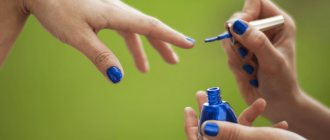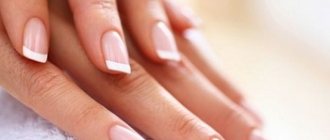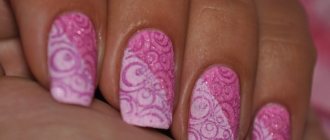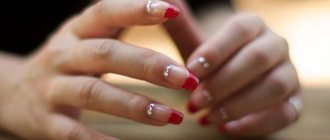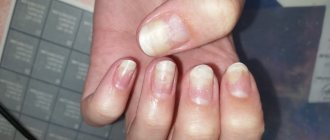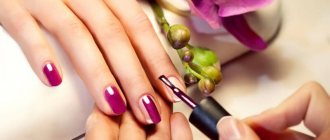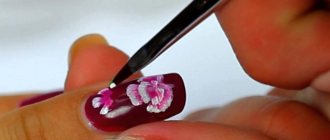If the nail extension procedure was performed incorrectly, then moldy fungus may appear on natural nails. Special preparations and folk remedies will help get rid of this nail defect.
Beautiful extended nails attract attention, because this is a sign that the owner of such an ideal manicure takes care of herself. But the extension process can hide dangers for nails.
Often, a few days after the procedure, the artificial nail plate becomes dull and mold appears underneath it. Why does this happen and is it dangerous for natural nails?
Mold on the nail under the gel? What is this? Photo
Masters in beauty salons can save on materials. This will lead to problems with the health of the nails - detachment of the artificial nail plate from the natural nail.
Moisture accumulates in the resulting pocket, and mold appears on the nail under the gel. What is this and how to fix it? Photos allow you to clearly see what this defect of an incorrectly performed procedure looks like.

The natural nail plate may become deformed. A woman should monitor the condition of her new nails.
IMPORTANT: If mold appears under the extended nails, then you need to go to the salon and have them removed.
If this is not done in a timely manner, the disease onycholysis may develop. The nail will change its color, and then recovery and treatment will take at least six months. In addition to mold, stains from ingrained materials may appear. Only a qualified technician will be able to determine the cause and origin of green spots on the nail plate.
Salon methods
In the salon, professionals will work on your nails using special cosmetics. To restore a damaged plate with whitish spots, several proven methods are used:
- sealing. This procedure involves applying a special product based on beeswax and honey. Thanks to such actions, a thin film covers the nails, and they look smooth and healthy;
- paraffin-based baths. With this procedure, peeling of the nails is eliminated, the plate is saturated with microelements. This bath helps rejuvenate the skin of your hands. Paraffin will fill the cracks that appeared after shellac coating;
- application of biogel. This procedure is aimed at restoring the nail plate. One course is enough to notice the result.
In specialized salons, they use special products that effectively cope with any of the problems. These include the IBX restorative complex, which fights nail splitting, restores their natural color and strengthens them.
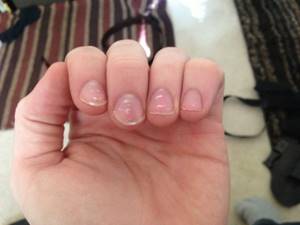
Nail fungus - mold
In a beauty salon, you can not only get the perfect manicure, but also infect your natural nails. Nail fungus and mold are closely related. When the nail plate becomes infected with mold fungi, color changes and deformation occur. Therefore, green mold spots may be visible under extended nails.

IMPORTANT: To avoid getting nails infected in the salon, the technician must disinfect the tools.
Ideally, he should use an autoclave. But this equipment is expensive and not available to everyone. It will be good if the manicurist has a device with an ultraviolet emitter.
IMPORTANT: UV rays kill many bacteria that cause infection.
Symptoms and possible complications
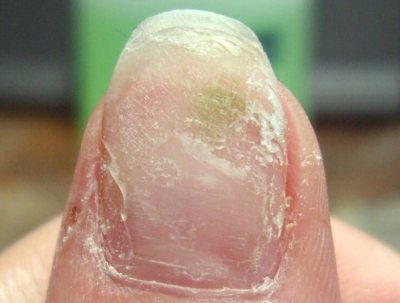
On the one hand, it is easy to confuse due to the presence of a blue-green coating, but only pseudomonia is pathogenic for the body, unlike fungus. Such a mistake by a manicurist can be costly. While the client tries to cure an ordinary fungus, spending money on medicine, Pseudomonas aeruginosa will continue to develop. The consequences of such negligence can be dangerous for the entire body.
The entire nail platinum is affected by pseudomonia within two weeks after extension. Fingers become red, swollen and painful. It is possible that the infection may spread to soft tissues and infect the entire body. Such cases, fortunately, are the exception rather than the rule.
When the first signs of changes in the nail appear, consult a doctor immediately. At the initial stage, eliminating Pseudomonas aeruginosa is not difficult.
What causes green mold to appear on nails?
Before starting the extension process, a qualified master examines the client’s hands and nails. There should be no damage, discoloration or other defects that indicate the presence of infection or any disease. If any imperfections in the nail plate are visible, then the master refuses to carry out the procedure.
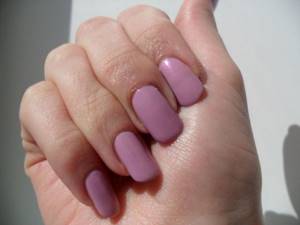
The reasons for the appearance of green mold on nails include the following aspects:
- weak immunity
- nail infection
- fungal disease
- improperly performed extension procedure
- constant contact of a woman’s hands with water, cleaning products and high temperatures
IMPORTANT: If you have a green coating on the nail plate, then after removing the extended nails, consult a dermatologist. He will make a diagnosis and prescribe the correct treatment.
Why do the nails on my hands turn green?
The formation of green areas on the nails can be caused by:
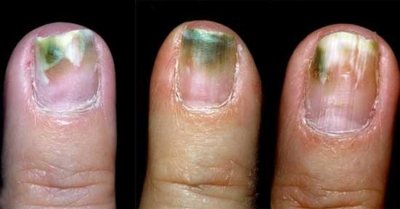
- Pseudomonas aeruginosa (pseudomonia) or aspergillus fungi. The ideal environment for their reproduction is the space between the nail and the nail bed.
Green nail syndrome predominantly affects women, as they are more likely to come into contact with water and detergents. In men, the disease manifests itself in the work environment: bakers, bartenders, cosmetologists. Nails thicken, crumble and peel off. An unpleasant odor and pain when pressed appear. - Onycholysis . Formed as a result of processing nails with contaminated or foreign tools and in the presence of artificial nail coating. As a result, greening and peeling of the nail plate occurs.
- Pseudomonas. These are common household bacteria that live in plants, animals, water or soil. As a rule, nails are not a favorite place for these bacteria, but in a favorable environment they can move here. Their nutrition consists of dead tissue of the nail plate. As a result, the nails become green, thicken and break. There is swelling and pain in the finger.
- Onychomycosis. A rare fungal infection that occurs mainly in older people and does not occur in children. It can occur due to regular injuries, prolonged contact with water and damage from manicure tools. The nail acquires a loose structure and peels off from the nail bed.
Pseudomony: description and photo
Let's talk separately about a common nail disease - pseudomonia. Pseudomonia is a blue-green mold that has formed under artificial material, such as gel. The causative agent of the disease is Pseudomonas aeruginosa, which lives in water, soil and places of high humidity, such as cosmetology, nail and hairdressing salons, as well as in hospitals. It can be found in shower sponges, lens solutions, hot tubs, etc.
The stick is resistant to many antiseptics and disinfectants and can survive for a long time even in a furatsilin solution. As it multiplies, it secretes the blue-green pigment pyocyanin.
The development of Pseudomonas aeruginosa is influenced by the immune status of a person. Under unfavorable conditions, it can cause severe infections of soft tissues and internal organs. The acidity of the environment also affects the development of pseudomonia. A favorable environment is a normal and slightly alkaline environment. Destructive - sour.
Based on early observations of Pseudomonas aeruginosa, it was found that its development proceeds faster under conditions of maximum oxygen in the air. But over time, it was discovered that even in conditions of limited access to oxygen (on the surface of the nails and under artificial turf), the bacteria multiplies no less. The main condition for the viability of the stick is a temperature of 30-37 ° C and high humidity.
Despite the assurances of organizations that equip nail salons with products that their technologies and materials do not allow infection, this is just an ordinary advertising campaign. Infection occurs most quickly under artificial surfaces. Next in the photo you can see what the disease looks like.
Nail mold treatment and medications
To treat moldy fungus on nails, various ointments, gels and varnishes are used.
- Lacquer Lotseryl and Batrafen are considered effective. The substances of these varnishes penetrate deep into the nail plate and produce a disinfecting effect.
- Lamisil with terbinafine hydrochloride in its composition works well against nail mold. This ointment has a wide spectrum of action and helps in the treatment of nail fungus and mold on the nail plate
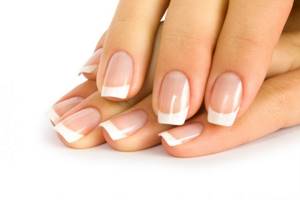
Popular drugs for mold fungus include Fluconazole. This medicine can be administered intravenously if the disease has complications or used as drops.
RECIPE: Apply the medicine to the nail plate a few drops. Wait until the liquid is completely absorbed. Repeat every day until complete recovery.
Exoderil solution can be used in the form of drops. This drug contains naftifine hydrochloride. This active substance reduces the formation of ergosterol, which is part of the cells of a fungal infection.
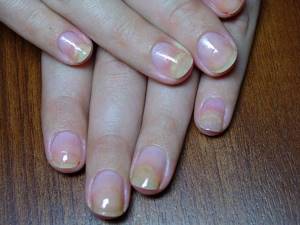
TIP: To completely cure the disease, use the medicine for at least one month.
Why can a finger peel and hurt?
Pain after such procedures is the first reason why it is better to refrain from them in the future. Pain may be due to the following reasons:
- Violation of shellac application techniques . During polishing, which is not recommended before applying the coating, the master excessively thinned the plate, and during removal, the solvent composition penetrated under the nail into the skin;
- The applied material turned out to be of poor quality and caused irritation , possibly an allergy, as evidenced by pain.
The pain that occurs after removing the coating can be a consequence of improper removal, or a reaction to the removing composition. It can also be assumed that before applying shellac, the nail plates were infected with a fungus.
The coating does not allow it to breathe, which creates a favorable environment for the development of a fungal infection, while simultaneously preventing it from being detected. During removal, the nail becomes completely defenseless. The acetone contained in the composition causes a chemical burn, and, as a result, pain.
In this case, restorative procedures and self-medication will not have an effect. You should seek help from a dermatologist, or even better, a mycologist. It would also be a good idea to visit a manicurist. In this case, nails should be treated after shellac using salon procedures, as well as a vitamin complex and external preparations. Immersion in aggressive environments such as detergents should be avoided whenever possible.
But what kind of primer is needed for gel polish, the content of this article will help you figure it out.
It is also worth understanding how to apply primer for gel polish in order to achieve maximum effect, as indicated in this article.
But what you need to apply shellac is detailed here: https://soinpeau.ru/kosmetika/dekorativnaya/lak/chto-nuzhno-dlya-shellaka-v-domashnix-usloviyax.html
Mold under the nail: folk remedies for treating nail fungus
After removing the extended nail, refrain from any manipulation of the nails. Perform only therapeutic procedures that help restore the nail plate. Folk remedies for treating nail fungus will help remove mold.
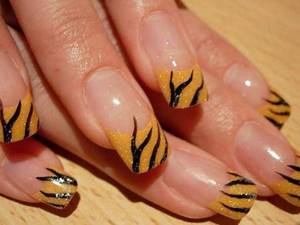
IMPORTANT: First, visit the salon and remove your nail extensions!
After this, you can begin treatment with folk remedies that will help make the nail plate strong and healthy.
RECIPE: Dissolve half a teaspoon of baking soda in a glass of warm boiled water. Lubricate the nail plate with this solution. After the soda water has dried, apply celandine oil.
If you buy birch tar at the pharmacy, then you can prepare an effective remedy.
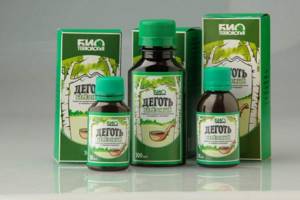
RECIPE : Steam your hands in a basin with warm soapy water (use laundry soap). If your nails are long, cut them. Spread the nail plates with birch tar. If possible, do not wash off this substance for 2-3 hours. Do this procedure every day and after a couple of weeks you can forget about moldy fungus on your nails!
Fungal infection does not like alkaline and acidic environments. Therefore, you can come up with your own recipes and alternate treatments for greater effectiveness.
TIP: Use lemon or apple cider vinegar as ingredients for nail masks.
Allergy to gel polish after the procedure
An allergic reaction can also cause pain in the nail area. Certain components of shellac are quite capable of causing an allergic reaction. So, if in the first days after the application procedures there is itching, burning, the coating should be removed urgently. But, most often, allergic reactions appear after several shellac procedures; by the way, allergies are also observed among the craftsmen themselves. You can find out what primer is needed for shellac by following the link.
This allows us to conclude that allergies occur due to the accumulation of one of the components of the composition in the body. For this reason, if you have a history of allergies, you should inquire about the composition of the shellac being applied. Today there are many compositions, and they are all different in structure, but the basic elements are present in all shellacs.
At the first manifestations of an allergy, you should contact your doctor to prescribe medications.
Signs of an allergy to shellac:
- Itchy sensations in the cuticle area and on the fingertips;
- Blisters on the skin around the nail bed;
- Swelling and hyperemia on the skin of the hands.
There are also frequent cases of respiratory manifestations of allergy to shellac. In these cases, antihistamines will be effective. You can find out what you need for gel nail extensions here.
On video - allergies after shellac:
Mold on nails: tips and reviews
It is very unpleasant when mold appears on your nails. Advice and reviews will help you get rid of the disease once and for all. Use local treatment - this will help restore the nail and make it strong.
Go to an appointment with a dermatologist and carry out all the necessary examinations that the doctor prescribes. In parallel with treatment with folk remedies, follow the doctor’s recommendations.
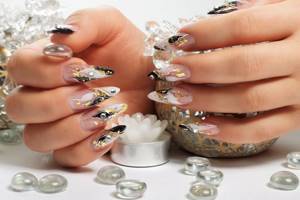
IMPORTANT: A disease such as moldy nail fungus requires patience. After all, to obtain an effective result, treatment must be long-term.
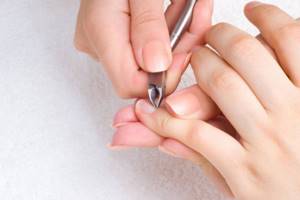
Entrust your manicure hands only to trusted professionals who have everything necessary to disinfect tools and their workplace.
Do not put your nails in danger; if you have any defects or diseases, avoid manicure for a while. Be healthy!
Home treatments
Applying and removing the coating always injures the nail. Anyone can get whiteheads, but there are several ways to get rid of them and get your nail plate in order. Home treatments are in no way inferior to salon treatments. By taking care of your nails at home, you save money and do restoration procedures at a time convenient for you. Of course, the duration of treatment is a little longer than with professionals, but this way you will learn how to restore a damaged nail plate in any situation, without resorting to the services of specialists. Here are some simple but effective ways:
1. Baths
based on sea salt or with the addition of olive oil. This procedure will strengthen the plate and moisturize the skin of the hands and soften the cuticle. Olive oil is slightly warmed up before use; about seven to ten procedures must be done. It is recommended to take a salt bath no more than 2-3 times a week. If there is irritation, then a chamomile bath will cope well with this problem.
2. Masks
:
- using lemon juice. It is necessary to rub the liquid into the nail plates;
- based on berries. Berries such as currants, cranberries, and rowan will do an excellent job of restoring damaged nails. It is necessary to prepare a paste and apply it to the nails, leave for no more than fifteen minutes;
- An iodine mesh will help strengthen your nails and relieve the negative effects of shellac.
During the treatment of the nail plate, it is better to refrain from using varnishes and cover the nails with nourishing agents.
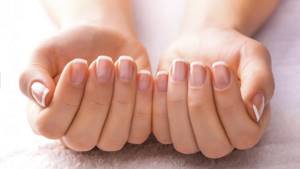
About the disease
Onycholysis is a disease in which the integrity of the nail plate is damaged, and the nail itself is partially or entirely separated from the bed.
This is easy to notice by the change in color, when the exfoliated area becomes identical in shade to the edges.
In some cases, the color may vary from bluish to burgundy.
At the initial stages, the peeling is not too noticeable, but gradually the damaged surface grows.
Based on the size of the lesion, onycholysis is divided into complete and partial. The choice of treatment method and specific drugs depends on the cause of the disease.
Main symptoms
The main sign that something is wrong with the nails is peeling at the edges of the plate. Gradually, the process can even reach the base of the nail, in which case there is a high risk of losing it completely.
In addition, you may notice other symptoms:
- uneven nail thickness, unevenness on the surface;
- color change;
- painful sensations;
- redness;
- purulent discharge;
- brittle nails;
- hematomas;
- bleeding.
Onycholysis is often confused with a fungus because the external symptoms may be similar. However, this disease has differences from a fungal infection:
- Onycholysis itself is not contagious unless it is caused by an infection.
- With fungus, the nail plate first changes color, becomes thicker, and then in the final stages begins to peel off. Onycholysis begins precisely with exfoliation.
- A fungal infection causes itching and redness.
- Nails affected by fungus have an unpleasant odor, which is absent in non-infectious onycholysis.
- The cause of fungal diseases is the activity of pathogenic microflora, while onycholysis is often caused by other reasons - trauma, pathological changes in the body, etc.
However, there are situations when both diseases occur simultaneously. Therefore, at the very first symptoms, you need to see both a dermatologist and a mycologist.
Based on the test results, it is already possible to make a correct diagnosis and choose the appropriate treatment.
What will help restore your nails as quickly as possible?
Regardless of the reason - you tripped, or pinched your finger, or the manicure procedure was poor - you need to remove the stain from a doctor, who must pierce the nail so that the required amount of blood flows out. But this procedure cannot be carried out at home, it is very dangerous.
If you hurt your finger and the nail turns black, then:
- You should immediately apply an object that has a low temperature to your finger - this will eliminate the most unpleasant bruises.
- If blood is bleeding from the skin under the nail plate, do not try to stop it. It will even be better if you put a little pressure on the nail so that more blood flows out. But before doing this, be sure to wash your hands thoroughly.
- Always keep your nail plates clean, especially if they darken. To do this, use a gauze bandage, plaster or bandages before visiting a doctor.
- Go to the emergency room if the skin on your fingers turns black quickly. Releasing blood and eliminating hematoma formations is unpleasant, but necessary, because then the nail will not begin to die and the pain will subside. So, be sure to see a doctor, especially if you have suffered bruises on your toes or hands.
If the plate turns black due to fungus, then you should not treat it yourself - there are different bacteria, and there are certain medications to eliminate each of them. Only with the help of laboratory tests can you find out exactly what kind of infection it is, after which a specialist can provide the patient with the correct therapy.
You need to remove the effects of the fungus with the help of compresses, soda-based lotions, and herbs. Products consisting of oils are also actively used. Timely medical examinations are also necessary. Pay close attention to your health, this will help avoid the appearance of dark spots on your nails.
Black
Black spots look very unattractive. They come in bright black or a desaturated shade.
Why do they appear?
Black spots on the fingernails or toenails are often caused by hematomas resulting from injuries. A blow with a heavy object, pinching or squeezing causes rupture of the vessels under the plate. The resulting blood becomes baked and turns dark burgundy or black. When pressing on the affected nail, pain is felt, which gradually subsides.
In addition to injuries, there are other reasons why black spots appear under the toenails or fingernails.
Among them:
- Diseases of the heart and blood vessels;
- Gastritis or peptic ulcer of the stomach or duodenum;
- Eating too much medium-rare meat;
- Lack of vitamins A, C, group B;
- Impaired blood flow in the region of the brachial artery. At the same time, you feel unwell and weak in your hands;
- Frequent use of decorative varnish in black or other rich dark shades, the coloring components of which penetrate into the structure of the plate;
- Liver pathologies associated with contamination of the organ. Appear as small black dots;
- Fungal infection (onychomycosis).
The cause may be a genetic factor. If your closest relatives have noticeable black stripes on their nails, then sometimes this defect is inherited.
If it is not a matter of injury, spots should not be left unattended or self-medicated. This is a serious reason to be wary and go to the doctor.
In addition to the reasons listed, they can be a sign of melanoma, a type of skin cancer. Especially if they occur simultaneously with skin rashes, multiple moles or papillomas.
Where to start restoring your nails
I recommend first understanding where nail problems come from, and why they need to be restored? By and large, there are only two options:
- Nails are damaged due to improper removal of gel polish
- Nails are damaged due to problems in the body.
I will dwell in detail on the first point - when problems with nails arose due to the removal of gel polish. If problems with nails are not related to manicure and removal of gel polish, then medical treatment of the body, not the nails, is needed. But today we are not talking about that.
Hematoma
Hemorrhage into the upper layers of the skin located under the stratum corneum is a hematoma. This is a blood clot formed due to rupture of capillaries. A dark spot spoils the appearance of well-groomed hands and causes discomfort.
A bruise cannot disappear or resolve on its own; it will disappear only after the old nail is completely replaced.
How is it formed
Blood (clots) accumulates under the stratum corneum after injury. This could be a blow, a fracture, or the impact of tight shoes on the lower limbs. More rare causes are taking medications that reduce blood clotting, cardiovascular diseases, and fungus.
Symptoms
There are several signs of a hematoma:
- swelling, swelling of the finger;
- hyperthermia;
- throbbing, sharp pain;
- dysfunction of the finger;
- redness and later blackening of the nail;
- feeling of fullness.
A bruise under the nail after an injury forms several hours later. After 2–3 days, such a spot will turn blue-black.
Important conclusions and what to do
Let us summarize important information about nail psoriasis and its symptoms.
Diagnostic features
Nail psoriasis is very common but often goes undiagnosed.
Manifestations of nail psoriasis can be minor, so even specialists often do not pay attention to it.
In 5% of cases, nail damage may be the only symptom of incipient psoriasis.
The manifestations of different diseases on the nails may look the same, which further complicates diagnosis.
The main manifestations of nail psoriasis:
- a symptom of a thimble - pits on the nail,
- white dots,
- crumbling nails,
- red dots in the hole area,
- nail detachment,
- longitudinal subungual hemorrhages,
- subungual hyperkeratosis - loose accumulations under the nail,
- oil stain symptom.
Psoriasis and fungus
- Nail psoriasis is often accompanied by a fungal infection.
- To definitely exclude it, you need to contact a mycologist and conduct additional research.
Nail psoriasis and psoriatic arthritis
Nail psoriasis is a common accompaniment of psoriatic arthritis.
It is important to detect pathological changes in joints as early as possible in order to begin treatment on time and avoid irreversible complications and disability.
Even if there are no external symptoms of arthritis, but nail psoriasis is detected, it is necessary to undergo an examination of the joints using ultrasound or MRI.



